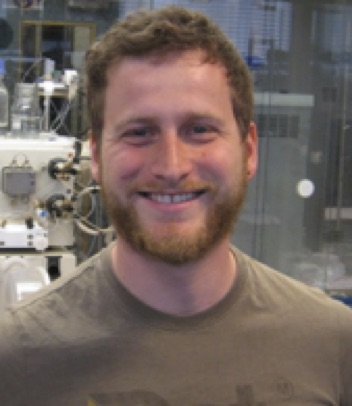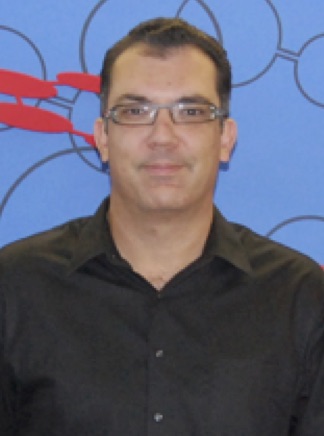Org. Synth. 2017, 94, 34-45
DOI: 10.15227/orgsyn.094.0034
Continuous Flow Hydration of Pyrazine-2-carbonitrile in a Manganese Dioxide Column Reactor
Submitted by Claudio Battilocchio, Shing-Hing Lau, Joel M. Hawkins, and Steven V. Ley
1*
Checked by Frederic Buono, Andrew Brusoe and Chris Senanayake
1. Procedure
A.
Pyrazinamide (1). A glass column reactor (
Note 1) is packed with
Celite (100 mg,
Note 2) at the bottom end of the column, amorphous
manganese dioxide (3.0 g,
Note 3) in the middle section of the column, and
Celite (100 mg) at the top end of the column (
Note 4). The glass column reactor is mounted vertically in a heating jacket (
Note 5) and connected to a pumping system flowing from the bottom to the top of the reactor column (Figure 1a) (
Note 6). Polyfluoroalkoxy (PFA) tubing (1/16" OD x 0.040" (1.0mm) ID) is used to connect the feed source to the pump and to connect the pump to the bottom inlet of the reactor column. Wider bore PFA tubing (1/8" OD x 0.062" (1.55 mm) ID) is used to connect the top outlet of the reactor tube to the product collection vessel (
Note 7). The reactor column containing the
manganese dioxide catalyst is equilibrated by flowing solvent,
H2O/
iPrOH (10:1 v/v), through the column at 1.6 mL/min at room temperature until the back pressure reaches a steady value (
Note 8). The temperature of the column is then increased to 98 °C while continuing to flow
H2O/
iPrOH (10:1 v/v) solvent through the reactor column at 1.6 mL/min. A 0.5 M solution of
pyrazinecarbonitrile (
2) (50.0 g, 476 mmol,
Note 9) in
H2O/
iPrOH (10:1 v/v, 910 mL) is charged to a feed source bottle (
Note 10).
Figure 1. (a) Cartridge that contains the MnO2, (b) Uniqsis flow system in operation
Once the reactor column has equilibrated to a stable pressure (
Note 11) and temperature of 98 °C the input to the pump is switched from solvent to the
pyrazinecarbonitrile solution, and the
pyrazinecarbonitrile solution is fed through the reactor at 1.6 mL/min while maintaining a reactor temperature of 98 °C (Figure 1b). The reactor output is collected in a clean vessel (
Note 12) where
pyrazinamide (
1) precipitates as white solid. Once the entire
pyrazinecarbonitrile solution is fed through the reactor (9.5 h), 20 mL of solvent,
H2O/
iPrOH (10:1 v/v) is passed through the reactor at 98 °C and 1.6 mL/min. The combined effluent from flowing the
pyrazinecarbonitrile solution and the subsequent
H2O/
iPrOH (10:1 v/v) solvent wash is allowed to crystallize by standing 14 h at 5 °C (
Note 13). The solid precipitate is filtered and dried
in vacuo to furnish 56.2 g (97%) of
pyrazinamide (
1) as a fine white powder (Notes
14,
15 and
16) (Figure 2).
Figure 2. (a) pyrazinamide in solution, (b) Filtration of pyrazinamide
2. Notes
1. Omnifit glass column, 10.0 mm i.d. x 100.0 mm overall length.
2.
Celite (AW Standard Super-Cel NF) was obtained from Sigma Aldrich and used as received.
3.
Manganese(IV) dioxide (10 μm, reagent grade, ≥90%) was obtained from Sigma Aldrich and used as received.
4.
Celite (0.1 g) is transferred into the Omnifit glass column; 3.0 g of
Manganese(IV) dioxide are transferred into the reactor column and the material is packed into the column with just a gentle tapping. Another portion of
Celite is then added (0.1 g) before closing the column with the frit end.
5. The column jacket allows heating from ambient to +150 °C, with precise temperature control; it accepts standard Omnifit glass columns (3 models for different Omnifit size ranges); two major safety aspects of the glass jacket are: the reaction is visible at all time and any hazard from column rupture is controlled by the shielding effect of the jacket itself.
6. A Vapourtec R2+/R4 flow reactor is used although any other system which could allow pumping an aqueous solution (with pressures up to 13 bar) and heating a column reactor can be used (e.g. Uniqsis, Phoenix ThalesNano, or Syrris flow reactors).
7. Wider bore tubing is used between the column exit and the effluent collection vessel to allow for precipitation of product in this line. The tubing outlet is held against the inner wall of the glass collection vessel to ensure that any precipitate does not build up at this point. The tubing is insulated using cotton wool and aluminum foil. The pressure was carefully monitored over time as the precipitation of the product in the outline (from the column to the receiver) may occur if the line was not well thermally isolated, that will cause fouling and clogging overtime. A back pressure regulator is NOT used after the reactor column.
8. At steady state, a back pressure of approximately 7 bar was observed; in some cases fluctuations between 5-10 bar were noticed. Typically 30 mL of solvent is required for equilibration.
9.
Pyrazinecarbonitrile (99 % purity) was purchased from Sigma Aldrich and used as received. The submitters used
pyrazinecarbonitrile (98% purity) purchased from Fluorochem Ltd.
10. The feed source bottle is a 1L glass bottle.
11. The pressure of the system ranges between 17-18 bar at operating conditions. The submitters report the pressure of the system ranged between 5-13 bar at operating conditions.
12. The collection bottle is a 1L glass bottle. Typically, to avoid precipitation within the reaction output, the tubing should be fixed to the inner side of the collection bottle allowing for the solution to flow down the bottle's inner wall rather than to drip.
13. Crystallization at room temperature provided isolated yields on the order of 75-78%, and the mother liquor and water wash showed that ~ 20% of
pyrazinamide product remained in solution.
14. A second reaction on identical scale provided 55.2 g (95%) of the product as a white solid.
15. The sample for analysis was prepared as a solution in
d6-DMSO in a J. Young NMR tube. White solid; mp 191-194 °C;
1H NMR
pdf(600 MHz,
d6-DMSO; 25 °C) δ: 7.88 (1 H, br s), 8.28 (1 H, br s), 8.72 (1 H, dd,
J = 2.5, 1.6 Hz), 8.86 (1 H, d,
J = 2.5 Hz), 9.21 (1 H, d,
J = 1.6);
13C NMR
pdf(100 MHz,
d6-DMSO; 25 °C) δ: 143.8 (CH), 144.1 (CH), 145.5 (C), 147.8 (CH), 165.6 (C). FT-IR (neat, ν): 3422, 3132, 1669, 1583, 1525, 1481, 1432, 1373, 1171, 1089, 1046, 1021, 870, 791 cm
-1.
16. Isolated product was analyzed by HPLC and weight assay was determined compared to a reference sample from Acros Organic (Lot A0355981). Weight % of products isolated was > 99.9 %. Column: Agilent Eclipse Plus 4.6 mm x 50 mm, observed at 254 nm, with flow rate of 1.4 mL/min. Method : Solvent A : water, Solvent B : Acetonitrile. Time : 0 min, % B : 10; 4 min, % B: 25; 6 min, %B: 45; 9 min, %B: 98; 12 min, %B : 98. Retention time = 1.05 min.
Working with Hazardous Chemicals
The procedures in
Organic Syntheses are intended for use only by persons with proper training in experimental organic chemistry. All hazardous materials should be handled using the standard procedures for work with chemicals described in references such as "Prudent Practices in the Laboratory" (The National Academies Press, Washington, D.C., 2011; the full text can be accessed free of charge at
http://www.nap.edu/catalog.php?record_id=12654). All chemical waste should be disposed of in accordance with local regulations. For general guidelines for the management of chemical waste, see Chapter 8 of Prudent Practices.
In some articles in Organic Syntheses, chemical-specific hazards are highlighted in red "Caution Notes" within a procedure. It is important to recognize that the absence of a caution note does not imply that no significant hazards are associated with the chemicals involved in that procedure. Prior to performing a reaction, a thorough risk assessment should be carried out that includes a review of the potential hazards associated with each chemical and experimental operation on the scale that is planned for the procedure. Guidelines for carrying out a risk assessment and for analyzing the hazards associated with chemicals can be found in Chapter 4 of Prudent Practices.
The procedures described in Organic Syntheses are provided as published and are conducted at one's own risk. Organic Syntheses, Inc., its Editors, and its Board of Directors do not warrant or guarantee the safety of individuals using these procedures and hereby disclaim any liability for any injuries or damages claimed to have resulted from or related in any way to the procedures herein.
3. Discussion
Pyrazinamide is an active pharmaceutical ingredient (API) for the treatment of tuberculosis.
3 A number of syntheses have been developed to produce this compound in good purity. However, most of these syntheses require multi-step processes that have significant economic disadvantages. For example, in the patent GB 451304,
4 the preparation begins with condensation of
o-phenylenediamine and glyoxal to provide quinoxaline. The carbocyclic aromatic ring is then oxidized to yield heterocyclic dicarboxylic acid. Decarboxylation followed by esterification and ammonolysis of the ester provide the desired product over several steps.
The preparation of primary amides
5,6 remains a practically problematic transformation, especially on large industrial scale.
7 The most environmentally-friendly way to obtain primary amides is
via hydration of nitriles. Despite the several methods that have been developed to perform this transformation, there are specific drawbacks associated with the existing protocols. For instance, acid or base catalyzed hydration is affected by over-hydrolysis or byproduct formation.
5,8,9 Relatively mild conditions are used for the homogeneous metal catalyzed
10 hydration of nitriles to primary amides, although issues associated with purification and cost-effectiveness of the process itself may hinder implementation.
Heterogeneous catalysis
11 represents a "green" alternative to give easy product collection and recovery of the catalyst. However, most protocols that are described in the literature demand relatively high temperatures (>140
oC) and downstream processing operations. In these cases, the use of expensive metal catalysts and leaching of the catalyst represent the main drawbacks for these protocols. We have recently developed a flow process for the hydration of nitriles using amorphous
manganese (IV) dioxide (
MnO2), as a cheap, sustainable, and recyclable catalyst for scalable processes.
12Indeed,
MnO2 has been known as a low-cost and useful reagent for its oxidative properties.
13 Previous work had identified
MnO2 as active catalyst for the hydration of nitriles.
14 Nevertheless, the procedures reported require high temperature (>140
oC) and laborious work up procedures, especially on scale.
In this work, we describe a flow procedure that provides a straightforward and rapid method for the preparation of
Pyrazinamide (
1). We demonstrate a single step continuous flow process to provide over a 50-gram scale of desired product from a low cost, commercially available starting material and a cheap metal oxide reagent with the use of sustainable solvents.
15 Furthermore, the yield and purity of the desired product are both excellent and the only work up operation of the protocol is the separation of the crystalline product from the output solution. This manuscript demonstrates the potential of flow chemistry for processing valuable pharmaceutical products on large scale for more sustainable manufacturing .
16,17
Appendix
Chemical Abstracts Nomenclature (Registry Number)
Celite: Diatomaceous earth; (91053-39-3)
IPA: Propan-2-ol; (67-63-0)
MnO2: Manganese (IV) Dioxide; (1313-13-9)
Pyrazinecarbonitrile: 2-Pyrazinecarbonitrile; (2) (19847-12-2)

|
Claudio Battilocchio received his bachelor degree from La Sapienza in 2008 and started his Ph.D. studies with Prof Mariangela Biava in 2009, researching the development of novel molecular hybrids. In 2011, he was a visiting Ph.D. student in the Innovative Technology Centre at the University of Cambridge working with enabling technologies. After a 3-year research position at the University of Cambridge working on the Open Innovation Programme with Pfizer Worldwide R&D, Claudio is now a research associate at Homerton College, working in the Ley group on a Collaborative Programme with Syngenta to explore new synthetic enabling tools. |

|
Shing-Hing Lau obtained his M.Sc. Chemistry with a year in industry (AkzoNobel N.V.) from Imperial College London in 2013, working on natural product synthesis for his master's project. In the same year he was awarded a Croucher Cambridge International Scholarship to pursue Ph.D. studies at the University of Cambridge under the supervision of Professor Steven Ley. His research focused on the development of sustainable processes using flow chemistry. |

|
Joel Hawkins received his Ph.D. at MIT in 1986 with Professor Barry Sharpless. He went on to become an NIH Postdoctoral Fellow at Caltech with Professor Robert Grubbs. As an Assistant Professor at the University of California at Berkeley from 1987 to 1993, he studied asymmetric Diels-Alder catalysts and fullerene chemistry. In 1993, he moved to Pfizer where he is a Senior Research Fellow in Chemical Research and Development and is particularly interested in the development and application of new technologies for pharmaceutical process research and development. |

|
Steven Ley is currently Professor of Chemistry and Director of Research at the University of Cambridge. He is also a Fellow of Trinity College and was BP 1702 Professor of Chemistry for 21 years. He was appointed as a lecturer at Imperial College in 1975, promoted to Professor in 1983, and became Head of Department there in 1989. In 1990 he was elected to the Royal Society (London) and was President of The Royal Society of Chemistry from 2000-2002. Steve's research interests span many disciplines including new synthetic methodologies, the total synthesis of natural products and the development of enabling technologies. He has published over 800 papers and has been honored with 50 major awards. |

|
Dr. Andrew Brusoe was born and raised in Toledo, Ohio. He received his Bachelor's degree at Albion College before earning his Ph.D. in organic chemistry in 2013 from the University of North Carolina at Chapel Hill working under Erik Alexanian. After completion of his degree Andrew was a postdoctoral researcher for John Hartwig at UC Berkeley. Andrew joined the process research flow chemistry group at Boehringer Ingelheim in October in 2015. Outside of work Andrew enjoys running, hiking, and roasting and brewing specialty coffee. |

|
Dr. Frederic Buono has 12 years of experience in Pharmaceutical Industry and he is currently working in Boehringer Ingelheim. He is originally from France, where he got his Ph.D. in organic chemistry and chemical engineer degree from "Ecole Centrale de Marseille". He moved to England to do his postdoctoral with Prof. Donna Blackmond, where he worked in the area of physical organic chemistry and developed several kinetic models of organic reactions mechanisms. Prior to Boehringer, he started his career with Bristol Myers Squibb, in the Process Group. In his current position, he is developing and implementing continuous flow technology for several projects on multi-kilogram scale process, by using in-situ monitoring techniques and kinetic studies. |
Copyright © 1921-, Organic Syntheses, Inc. All Rights Reserved